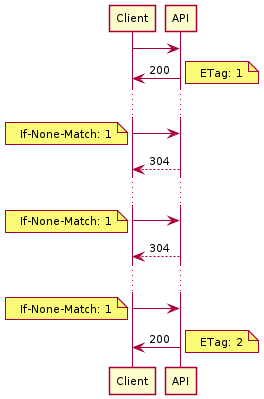Pattern Sections
Pattern: Conditional
Request 
a.k.a. Conditional Retrieval, Conditional Modifications (Google Calendar API terminology)
Context
Some clients keep on requesting the same server-side data repeatedly. This data does not change in between clients requests.
Problem
How can unnecessary server-side processing and bandwidth usage be avoided when frequently invoking API operations that return rarely changing data?
Forces
The following forces apply when solving this problem:
- Complexity of endpoint, client, and message payload design and programming
- Accuracy of reporting and billing
- Size of messages
- Client workload
- Provider workload
- Data currentness versus correctness
Pattern forces are explained in depth in the book.
Solution
Make requests conditional by adding Metadata Elements to their message representations (or protocol headers) and processing these requests only if the condition specified by the metadata is met.
Sketch
A solution sketch for this pattern from pre-book times is:

Example
Many Web application frameworks, such as Spring, support Conditional Requests natively. The Spring-based Customer Care backend application in the Lakeside Mutual scenario includes ETags – implementing the Fingerprint-Based Conditional Request variant – in all responses. For example, consider retrieving a customer:
curl -i http://localhost:8080/customers/1c184cf1-a51a-\
433f-979b-24e8f085a189A response could start with:
HTTP/1.1 200
ETag: "0c2c09ecd1ed498aa7d07a516a0e56ebc"
Content-Type: application/hal+json;charset=UTF-8
Content-Length: 801
Date: Wed, 20 Jun 2018 05:36:39 GMT
{
"customerId" : "1c184cf1-a51a-433f-979b-24e8f085a189",
...Subsequent requests can then include an ETag to make the
request conditional:
curl -i -H 'If-None-Match: "0c2c09ecd1ed498aa7d07a\
516a0e56ebc"' http://localhost:8080/customers/1c184c\
f1-a51a-433f-979b-24e8f085a189If the entity has not changed, i.e., If-None-Match
occures, the provider answers with a 304 Not Modified
response including the ETag:
HTTP/1.1 304
ETag: "0c2c09ecd1ed498aa7d07a516a0e56ebc"
Date: Wed, 20 Jun 2018 05:47:11 GMTIf the customer has changed, the client would get the full response, including a new ETag. RFC 7232

Note that this implementation of
Conditional
Requests is implemented as a filter applied to the response. This
means that the response is still computed, but then discarded by the
filter and replaced with the 304 Not Modified status code.
This approach has the benefit of being transparent to the endpoint
implementation; however, it only saves bandwidth and not computation
time. A filter applied to the request would also work in conjunction
with a server-side cache.
Are you missing implementation hints? Our papers publications provide them (for selected patterns).
Consequences
The resolution of pattern forces and other consequences are discussed in our book.
Known Uses
Some of the highly visible and frequently accessed Public APIs on the Web implement this pattern:
- The GitHub API
v3 uses ETags in most of its responses. Responses that return a
304 Not Modifieddo not count against the Rate Limit to encourage clients to use them. - In the Google Calendar API, ETags are used, both when modifying and when retrieving calendar data.
- Clients of Salesforce’s
REST API have the choice between ETags and
If-Modified-SinceorIf-Unmodified-Sincewith a timestamp to make requests conditional.
Web application frameworks typically include some support for Conditional Requests. For example, Spring has a ShallowEtagHeaderFilter that calculates an ETag from the response body. The Play Framework offers a CacheControl library to help developers implement the HTTP caching model.
Some exemplary usages of the patterns in node.js are discussed in this RisingStack blog post.
More Information
Related Patterns
Using a Conditional Request may have a positive influence on a Rate Limit that includes response data volumes in the definition of the limit, as less data is transferred when this pattern is used.
The pattern can be carefully combined with either
Wish
List or
Wish
Template. This can be rather useful to indicate the subset of
resource data that is requested if the condition evaluates to
true and the resource needs to be sent (again).
Chapter 10 in “RESTful Web Services Cookbook” (Allamaraju (2010)) is dedicated to conditional requests. Some of the nine recipes in this chapter even deal with requests that modify data.